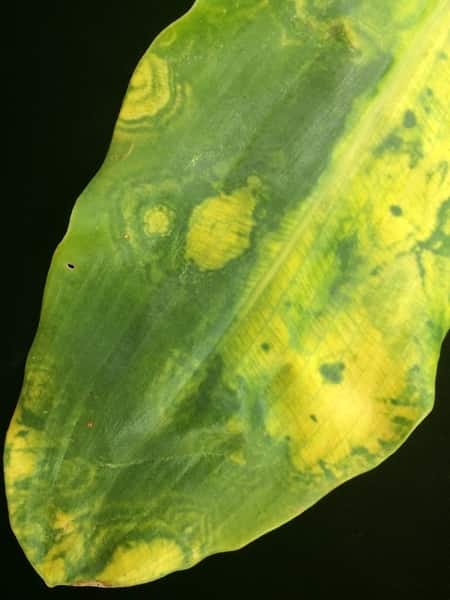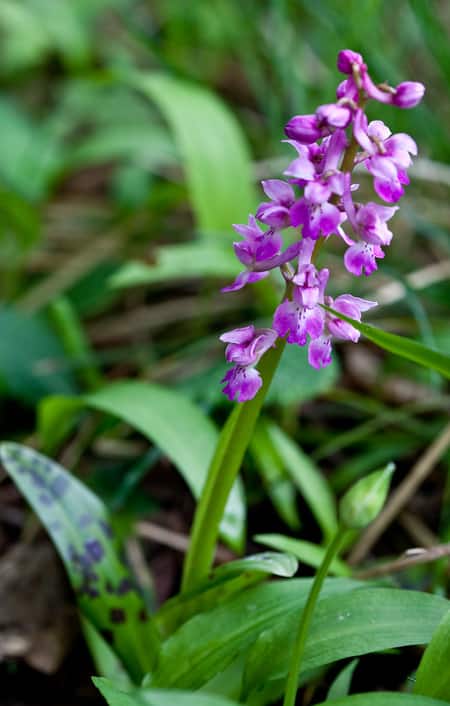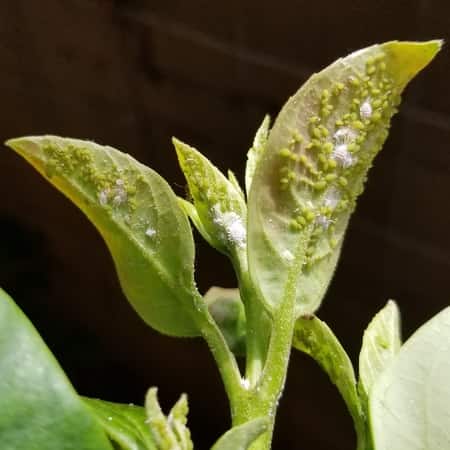Plant pathology is not a pleasant subject, but orchids get sick just like humans do. Bacterial infections are common among orchids, mainly due to watering and humidity, and lots of how-to guides have been written about how to treat them.
But when a virus infects an orchid, it’s hard to know what to do. After all, how do you know when a virus has infected an orchid, and most importantly, how do you treat it.
There are over thirty different viruses that infect orchids, (which is good news because there are over 5,000 known viruses that affect humans).

The bad news is that there is no cure for any of the 30 them, but we’ll talk about that more below.
Of those 30, there are only two that are common among orchid in the household setting: Cymbidium Mosaic Virus and Odontoglossum Ringspot Virus.
This article will focus only on Ringspot Virus, commonly called ORSV.
How do you know your orchid is infected with ringspot virus? Are there any symptoms?
Ringspot virus is easily detected on the orchid leaves. Circular patters of either lighter or darker concentric circles will form on the leaves. These patterns, called chlorotic and necrotic ringspots, occur because of the breakdown of chlorophyll and cell death.
Who’s responsible for this virus?
The pathogen that infects orchids with Ringspot Virus is commonly referred to as the orchid strain of the Tobacco Mosaic Virus. It also infects many other plants and is the common factor among other diseases, including Cymbidium diamond mottle, Cattleya infectious blossom necrosis, Cattleya mild flower break, and Cattleya color break. Not a friendly little guy.If you want more technical information on this pathogen, this article written by Carlye Baker entitled “White Phalaenopsis Ringspots –Mystery Solved” has a very good explanation of the process. It was published in Plant Pathology.
written by Carlye Baker entitled “White Phalaenopsis Ringspots –Mystery Solved” has a very good explanation of the process. It was published in Plant Pathology.
Another article that explains more into in the specific botanical/horticultural side of this pathogen can be found in this article, Dual Resistance of Transgenic Plants Against Cymbidium Mosaic Virus and Odontoglossum Ringspot Virus, published on PubMed and written by Ting-Yu Chen.
published on PubMed and written by Ting-Yu Chen.
Which orchids are the most affected by ORSV?
All orchids can become infected if the are next to another plant with the virus. There are more hardy orchids that can resist for longer periods of time, but the infected orchid will eventually transmit the Ringspot Virus to other orchids.


The most commonly affected orchids are:
Odontoglossum
(thus the name),
Encyclia,
Laelia,
Cymbidium,
Cattleyas,
and Phalaenopsis.
I have not yet found a reason as to why this occurs.
Diagnosis of ORSV
Ringspot Virus can only be diagnosed with proper testing. Even though it’s easy to see the rings form a circular pattern on the leaves, there are other possible causes for these. Although it’s unlikely that these possibilities form in perfect concentric circles, Ringspot virus can be confused for bacterial problems.
Each orchid will present signs in a peculiar way. Signs vary depending on your temperature, how much light exposure the orchid receives, how well they are fertilized, if there is salt residue on them and many other variables.
Proper testing using the Enzyme Linked Immunosorbent Assay (ELISA) test, can be done in laboratories. You can send the sample leaf into the lab and they will analyze it. There are other strip tests that can be done, but to go into those, will be beyond the scope of this article. Here is a link to a PDF that talks more about testing different viruses.
that talks more about testing different viruses.
To be sure that your orchid has the Ringspot Virus without all the testing, check all the other possible conditions that could mask this disease. Are the roots in perfect health? Does your orchid get enough light? How is your watering schedule? Is the potting mix broken down? What’s the pH of your orchid potting medium?
All these factors will interfere with how ringspot will appear on the leaves. The most important factors are: are there any signs of aphids and thrips on your plant? These pests are extremely prone to transmitting viruses and may be the underlying cause of how Ringspot affected your orchid in the first place.
Treatment of Odontoglossum Ringspot Virus
…and here’s to the bad news. There is no treatment. You have to toss your orchid, and when you do, toss it quick. There is no saving the leaf, even if you cut it off.
Ringspot infects the orchid as a whole, and even though the signs are present on a specific leaf, the pathogen has traveled through the internal vascular system of the orchid, called xylem, and infested every part of your orchid.
If you don’t toss it, the virus will infect all your other orchids in your collection. It’s a shame, and I wish there was something else I could say, but…. Yeah, just rip if off like a band-aid, toss it, and head to the market to get a healthy one.
How to Prevent Ringspot
Ringspot Virus will infect other orchids with the sap that they produce.
Pests and insects will also carry the virus from plant to plant, so you need to observe your orchid closely for aphids and thrips. Only insects also are carriers of the virus, but these are the most common.
As for aphids, look for tiny white yellowish-white dots that move.

They are usually on the bottom of the leaf. These little guys are tiny, but with good lighting and careful observation, they can be spotted.
Larger aphids infect entire plantations and can grow quite big, but they always start off tiny.
As for thrips, look for black, elongated, mini-centipede type bodies with two projections off their heads, like soft horns. They are the biggest of the pests (which doesn’t mean they’re big…) but they look like little creatures from a Greek-dragon, sci-fi movie. Or something from those alien infestation movies… but much smaller (Thank God!).
Another way to prevent Ringspot Virus to to provide proper fertilization. There are several methods and you need to pick one that is the best for your needs. This article goes over the 5 different methods of fertilizing, and I do suggest a few that I like (and don’t like). You can also print out a free 14-page guide on fertilization here, which will be sent to you as a PDF file to download.
You need properly fertilize, rid your orchid of any visible vectors for the infestations, but the most common way of infecting an otherwise healthy orchid with Ringspot Virus is during the trimming and pruning of leaves. That is why it is always crucial that whenever you trim an orchid leaf, you sterilize your equipment.
Methods to Properly Sterilizing your Orchid Euipment.
-Flame: Use a flame and go up and down the surface area of your scissors, knife or razor blade. Do this for at least 10 seconds, never less.
-Alcohol: Let your instrument soak in alcohol for 30 minutes for a chemical treatment, then scrub with a cotton ball to physically remove all pathogens.
-Bleach: Mix a teaspoon of bleach in a cup of water and dip your cutting utensil in the solution for 30 seconds.
The best attack is a good prevention, and in the orchid world, that means buying orchids from only reputable sellers. Since the virus can go undetected for a while and appear asymptomatic, this only increases the probability of infecting other orchids close to it.
More Information: You can check out this article from Iowa State University, written by the plant pathologist, Paula Flynn.
written by the plant pathologist, Paula Flynn.
In all honesty, I hope your orchid doesn’t have Ringspot Virus. If that is what you suspect it is, just toss it, lament it’s loss, and go get another orchid from a healthy, certified grower. It’s not worth the possibility of contaminating other orchids near it.
Older orchids have more probability to get infected with ORSV than newer orchids do. Yet, surprisingly so,seedlings and keikis hardly ever get contaminated with the virus. Research has shown that the more the orchid is handled, repotted, changed media, changed locations, and so on, the less it has chances to recover.
Recover? I thought you said there was no cure.Yeah… About that… there isn’t. Just tender loving care , but…
If you are the positive type, and want to defy the odds, I won’t kid you. There have been positive results from killing Ringspot Virsus. So your orchid can be saved…BUT it will take four to five years, and not bloom during this time.
I’m not the person to tell you how to do that. This was done in a professional greenhouse/lab and with more observation and detailed methods I wouldn’t even know how to describe.
So, if you don’t want to give up quite yet, keep looking. The answer is out there… In the meantime, please separate your orchid from the others in your collection.
Don’t Stop Learning!
If you want to be included in more information and get a 14-page fertilization guide, please sign up for my newsletter. I don’t spam, but send emails out bi-monthly with some curious topics of interest. If you want more information, click here to go to a specific page on this website where I explain it more in detail.

Also, if you are looking for an orchid journal to keep your notes specifically about orchid care, check out my 2 solutions for that on this page. If note-keeping isn’t your thing, then there is a free excel spreadsheet that you can download. Click here for more information on how to do that.
If you subscribe to my newsletter, I will send you a 14-page guide on the main tips of orchid fertilizer. It is downloadable and you can print it out on your computer. I designed the guide to double up as a coloring book, just to make it fun.
Happy Cultivating!

